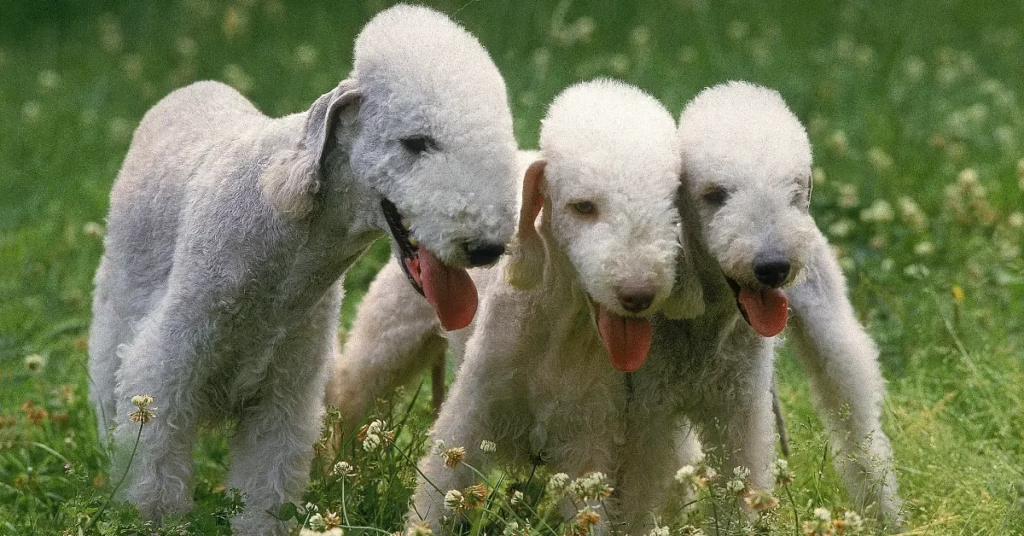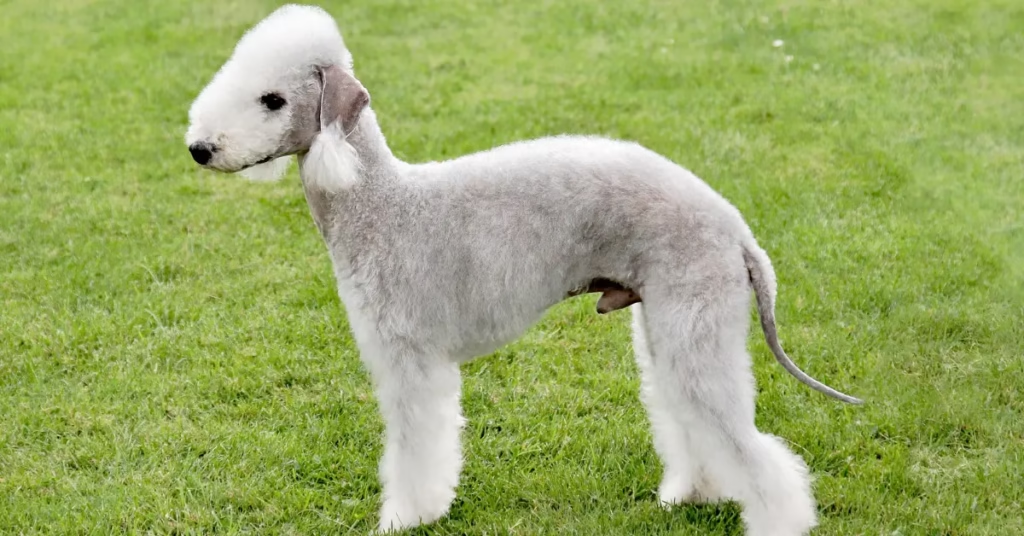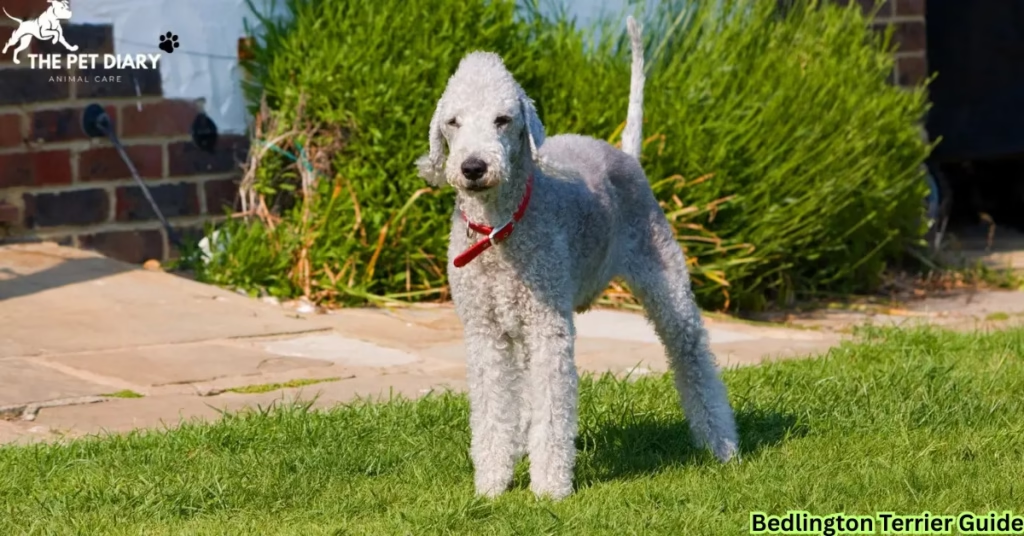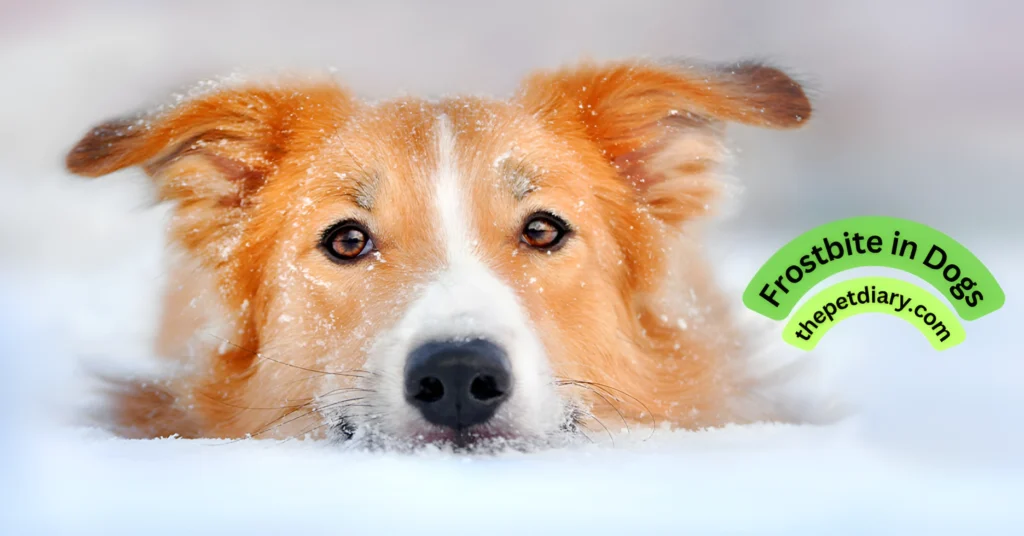The Bedlington Terrier is one of the most distinctive and charming small dog breeds in the world. Famous for its lamb-like look and intelligent, affectionate nature, this dog manages to be both a lively companion and a calm housemate. Whether you live in a bustling city apartment or a quiet suburban home, the Bedlington offers a unique blend of elegance and energy that appeals to singles, families, and even retirees, making it a perfect addition to any detailed Bedlington Terrier.
Because the breed is hypoallergenic and low-shedding, it is often recommended for households with allergy concerns, adding another reason why dog lovers everywhere are drawn to this graceful terrier.
Breed Overview/ Bedlington Terrier:
| Feature | Details |
|---|---|
| Breed Group | Terrier |
| Height | 15–17 inches |
| Weight | 17–23 pounds |
| Coat Type | Curly, woolly, non-shedding |
| Life Expectancy | 12–16 years |
| Energy Level | Moderate to high |
| Best For | Families, singles, apartment living |
History and Origin
The story of the Bedlington Terrier begins in Northumberland, England, during the early 19th century. Miners and poachers in Bedlington wanted a dog capable of hunting vermin, rabbits, and even badgers. They crossed various terrier breeds, including the Rothbury Terrier and Whippet, to create a dog that was fast, courageous, and athletic.
Despite its delicate, lamb-like appearance, the Bedlington of those days was a fierce hunter and a dependable working dog. Over time, as industrialization reduced the need for hunting companions, the breed’s unique look and pleasant temperament attracted pet owners, transforming it from a fearless ratter to an admired family companion and show dog.
Today, the Bedlington Terrier is recognized by major kennel clubs worldwide, including the American Kennel Club (AKC), which places it in the Terrier Group.
Appearance: A True “Lamb Dog”

One glance at a Bedlington Terrier and you’ll understand why it is often called the “dog that looks like a lamb.”
-
Head and Body: The breed is known for its pear-shaped head, narrow muzzle, and graceful arched back, giving it a distinct silhouette.
-
Coat and Color: The coat is a crisp mix of soft and harsh hair, forming tight curls that do not shed much. Standard colors include blue, liver, or sandy, sometimes with tan markings.
-
Eyes and Expression: Dark, almond-shaped eyes and a gentle, inquisitive expression highlight their intelligence and alertness.
This elegant appearance isn’t just for show. It reflects a history of agility and endurance.
Temperament and Personality
Bedlington Terriers offer a personality that balances playful energy with loving companionship:
-
Affectionate & Loyal: They adore their families and love to stay close to their people, often following them from room to room.
-
Intelligent & Curious: Quick to learn and eager to please, they excel in obedience and problem-solving games.
-
Alert but Calm: Naturally watchful, they make good watchdogs without excessive barking.
-
Adaptable: Happy in apartments or houses, they adjust to different lifestyles as long as they receive enough exercise and attention.
Unlike some high-energy terriers, the Bedlington enjoys a mix of active outdoor time and peaceful indoor relaxation, making it ideal for owners seeking both playfulness and tranquility.
Bedlington Terrier Grooming and Coat Care
One of the breed’s most appealing traits is its hypoallergenic, low-shedding coat, but this beauty requires maintenance:
-
Brushing: Use a slicker brush 2–3 times a week to prevent mats and tangles.
-
Professional Grooming: Every 6–8 weeks, a professional trim keeps the lamb-like outline neat.
-
Bathing: A gentle bath every month or as needed keeps the coat clean and soft.
-
Nail, Ear, and Teeth Care: Regular nail trims, ear cleaning, and dental hygiene help prevent infections and dental bedlington terrier infectious disease.
While grooming takes commitment, many owners find the effort worthwhile for a nearly non-shedding pet.
Exercise Requirements:
Although the Bedlington Terrier is small, it has a moderate-to-high energy level:
-
Daily Walks: At least 30–40 minutes of brisk walking or jogging is ideal.
-
Playtime: Interactive play such as fetch or tug-of-war keeps them happy.
-
Off-Leash Fun: They love a secure fenced yard or dog park where they can sprint, a throwback to their whippet ancestry.
Physical activity is vital, but so is mental stimulation. Puzzle toys, scent games, and agility courses help keep their intelligent minds sharp and prevent boredom.
Diet and Nutrition:
Feed a high-quality, balanced diet formulated for small, active breeds. Look for dog foods rich in lean proteins (chicken, fish, or lamb), complex carbohydrates, and healthy fats.
-
Portion Control: Divide meals into two servings to maintain steady energy and avoid weight gain.
-
Fresh Water: Always use clean water, especially after play or exercise.
Consult your veterinarian to tailor portions to your dog’s age, weight, and activity level.
Health and Lifespan:

With good care, Bedlington Terriers typically live 12–16 years. They are generally healthy but can be prone to specific conditions:
-
Copper Toxicosis: A hereditary liver disease; reputable Bedlington terrier breeders screen for this.
-
Eye Problems: Cataracts or retinal issues may occur in later years.
-
Joint Concerns: Regular exercise and proper weight management help protect hips and knees.
Routine vet check-ups, vaccinations, and annual dental cleanings ensure a long, happy life.
Training Tips and Socialization
Training a Bedlington Terrier is a rewarding experience thanks to its intelligence and willingness to please:
-
Positive Reinforcement: Use treats and praise for desired behavior. Harsh methods can cause anxiety.
-
Early Socialization: Introduce them to different people, pets, and environments from puppyhood to build confidence and reduce shyness.
-
Obedience and Agility: They excel in obedience classes and canine sports such as agility and rally.
Consistent, gentle training helps bring out the best in their affectionate and clever nature.
Living with a Bedlington Terrier
This breed adapts beautifully to various lifestyles:
-
Families with Children: Friendly and gentle with kids when properly socialized.
-
Multi-Pet Homes: Generally good with other dogs and even cats if introduced early.
-
Apartment Living: Their moderate size and calm indoor behavior suit city life, as long as daily exercise is provided.
Because they thrive on companionship, Bedlington Terriers do best in homes where they are not left alone for long periods.
Travel and Activities
Their adaptable nature makes them excellent travel companions. They enjoy hiking, beach walks, and even agility competitions. Always use a secure harness when traveling and provide breaks during long car rides.
Choosing a Bedlington terrier puppy or a Rescue
If you’re considering adding a Bedlington Terrier to your family:
-
Find a Reputable Breeder: Ensure health screenings for copper toxicosis and other genetic conditions.
-
Bedlington terrier dogs for adoption: Breed-specific rescues and shelters sometimes have Bedlingtons or mixes needing loving homes.
Conclusion of Bedlington Terrier:
The Bedlington Terrier is a rare treasure among small breeds. Behind its lamb-like appearance lies a brave hunter’s heart, a playful spirit, and a deeply affectionate companion. With regular grooming, moderate daily exercise, and loving attention, this hypoallergenic terrier will reward you with loyalty, charm, and countless joyful moments for many years. Learn more at ThePetDiary.com.
FAQs of Bedlington Terrier:
1-Are Bedlington Terriers hypoallergenic?
-
Yes. Their curly, low-shedding coat is often suitable for allergy sufferers.
2-How much daily exercise do they need?
-
About 30–40 minutes of brisk activity plus mental enrichment.
3-Do they get along with kids and pets?
-
With early socialization, they are friendly with children and can coexist with other pets.
4-How long do Bedlington Terriers live?
-
The average lifespan is 12–16 years, with some living longer when well cared for.


